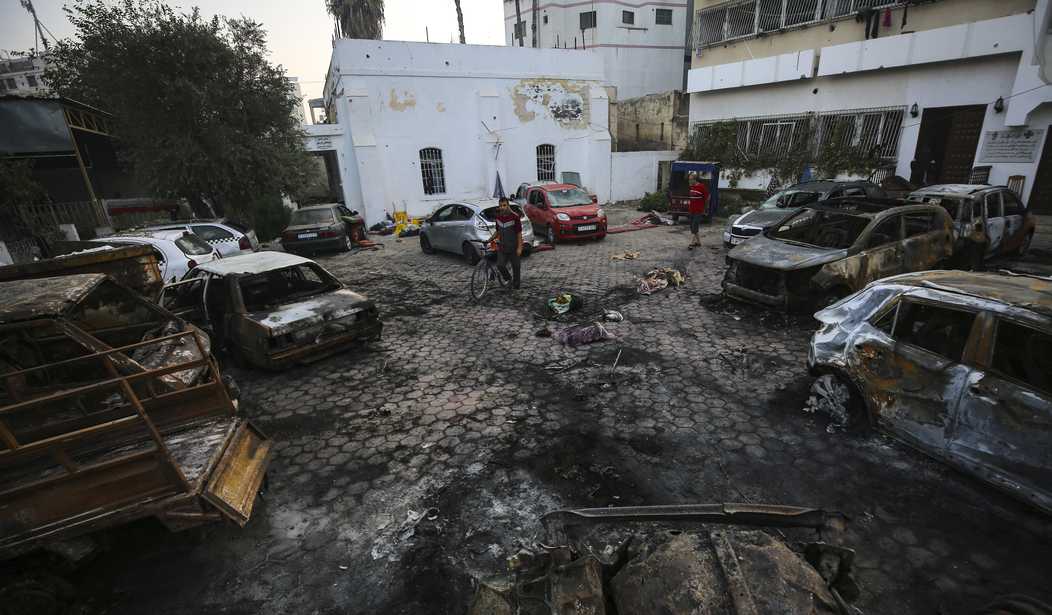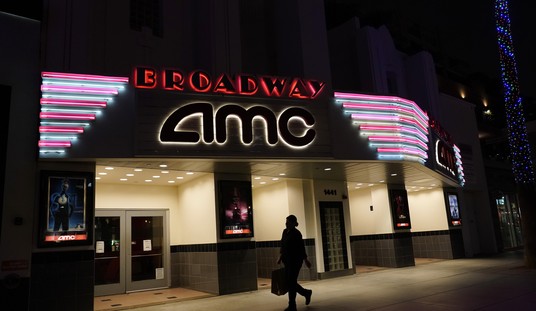If you’ve been following this story at all then you already know that every major news outlet has tried to independently investigate the explosion that took place at a Gaza hospital. The latest such examination comes from the Washington Post.
The bottom line of this investigation is that the Post agrees with the NY Times conclusion, published two days ago, about a widely seen video which shows a midair explosion. That rocket, or whatever it was, exploded several miles away from the hospital, closer to the Israeli border. As the Post puts it, the explosion “most likely had nothing to do with the hospital explosion.”
But what’s noteworthy about the Post report is that it doesn’t open or focus on that explosion which had nothing to do with the hospital. For comparison purposes, here’s how the NY Times story opened:
The video shows a projectile streaking through the darkened skies over Gaza and exploding in the air. Seconds later, another explosion is seen on the ground.
The footage has become a widely cited piece of evidence as Israeli and American officials have made the case that an errant Palestinian rocket malfunctioned in the sky, fell to the ground and caused a deadly explosion at Al-Ahli Arab Hospital in Gaza City.
To the Post’s credit, they don’t open with the side story about the video, they remain focused on the actual story, i.e. the hospital explosion.
Fighters in Gaza launched a barrage of rockets toward Israel and in the direction of al-Ahli Hospital 44 seconds before an explosion there that killed at least 100 people, according to a visual analysis by The Washington Post.
Video obtained from Israeli television channel Keshet 12 News allowed The Post to geolocate the origin of the barrage to a point southwest of the hospital in Gaza City, matching the rough location the Israeli military has alleged was the launch site of a misfired rocket that it said landed on the hospital grounds. Experts said rockets from that barrage would have been able to reach the hospital in time for the explosion.
The analysis of that and other videos, in addition to expert review of imagery of the blast site, provides circumstantial evidence that could bolster the contention by Israel and the U.S. government that a stray rocket launched by a Palestinian armed group was responsible for the Oct. 17 explosion…
None of the more than two dozen experts consulted by The Post was able to say with certainty what kind of weapon struck the hospital grounds or who fired it. But munitions experts agreed that the damage at the hospital was consistent with a rocket strike. They said it was not consistent with an airstrike, which would have caused much greater destruction, or with an artillery strike, which would have left substantial fragments and probably not caused the massive fireball seen in videos.
A DNI spokesman wouldn’t comment on the Post’s findings but did say they had high confidence the hospital explosion was caused by a Palestinian rocket “based on unpublished intercepted phone conversations, an analysis of the damage at the hospital, and four publicly available videos.”
There’s a big tonal difference between these two stories. The Times focused narrowly on evidence about the video while the Post emphasizes the fact that, despite the confusion over the video, the evidence still seems to be pretty strongly in favor of this being caused by a Palestinian rocket.
Later in the story the Post reports that two different academic experts confirmed a Palestinian rocket launched from the site confirmed by the Post could have reached the hospital in the time between the launch and the explosion, which was 44 seconds. One expert estimated a rocket would take 25 to 45 seconds and the other estimated 26 to 37 seconds. Since the barrage of rockets lasted 14 seconds, that means a rocket strike does fit the timeline pretty closely.
Finally, both Jazz and I have written about the conspicuous fact that no remaining pieces of whatever hit the hospital have been found. One war crimes investigator said he’d never seen a case without some remaining fragments left behind in 20 years of investigations. So where did they go?
Well, today the BBC published a photo showing Palestinian Ordinance Disposal personnel working at the impact crater on the night of the attack. You’ll have to click here for the photo but it’s basically several guys surrounding the crater, one of whom is digging into it with his hands.
Pictures taken in the immediate aftermath show Hamas-led security forces on the scene, with officers wearing tops with logos of the Palestinian police’s Explosive Ordnance Disposal Unit examining the crater.
But we have not seen any evidence of weapon fragments being recovered and there has been no significant update from officials in Gaza about their investigation.
Hamas told the New York Times that the missile had disintegrated beyond recognition. “The missile has dissolved like salt in the water. It’s vaporised. Nothing is left,” said Ghazi Hamad, a senior Hamas official.
In other words, we don’t have to speculate that maybe some Hamas operatives got to the scene and removed whatever evidence was there. We have a picture showing them doing it. Despite the missing evidence, the crater and the surrounding damage don’t match up well with anything other than a rocket full of fuel.
“I can categorically say this wasn’t an airstrike,” Garlasco said.
Garlasco noted the large amount of what he called “localized thermal damage,” meaning destruction from fire, which he said is not common in airstrikes. Such a scene, he said, is instead more consistent with a munition “with a lot of fuel in it” falling to the ground prematurely and igniting along with its warhead. That would create a flash fire that ignited the compound with concentrated rather than widespread damage, Garlasco said.
The size of the crater and the blast bore some similarities to an impact from a 155-millimeter artillery round, a munition in the Israeli arsenal, said Chris Cobb-Smith, a security consultant and former artillery officer in the British army. But other weapons could do the same, and an artillery round would not have produced the fireball seen in the blast videos, he said.
Credit where it’s due. The Post did a nice job here of putting forward the facts and letting the chips fall where they may, but also of staying focused on the big picture. The Times report rushed out Tuesday only created more confusion. You have to wonder if that wasn’t because the paper had already embarrassed itself on this so thoroughly.








Join the conversation as a VIP Member